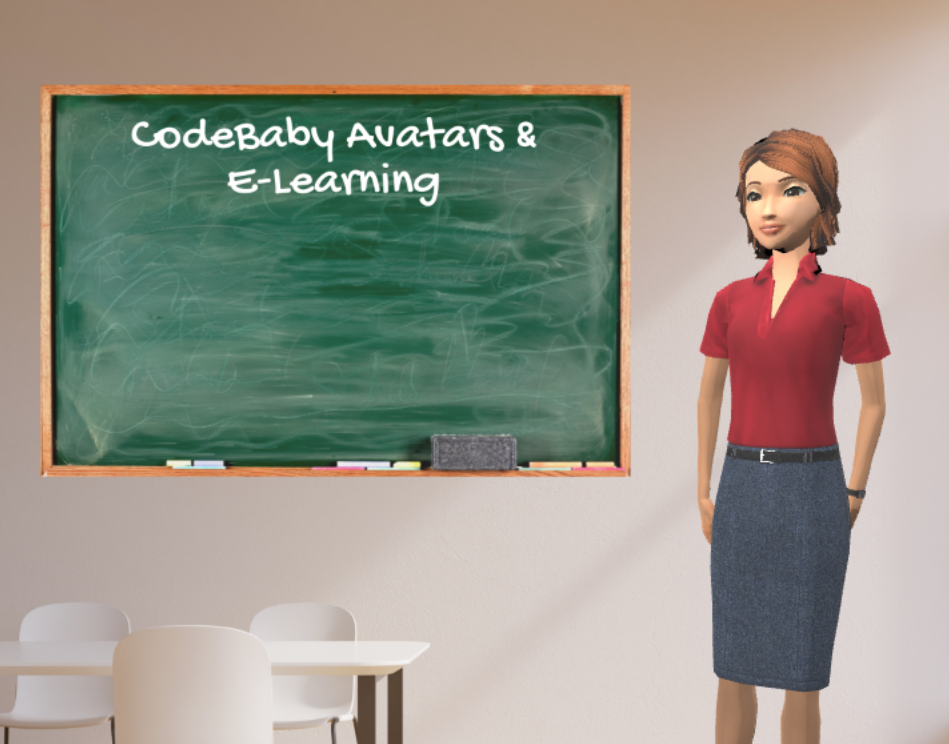Avatars, actors and pedagogical characters are just some of the many terms describing characters representing humans in an online environment. Prior to animation tools and interactive character solutions, such as CodeBaby®, characters primarily took the form of 2D photorealistic cartoons or even anthropomorphized animals.
Learner expectations and technological advances in eLearning development make animated character mediated learning easier to implement while at the same time employing more sophisticated instructional design techniques.
But why are integrated animated characters beneficial to the eLearning environment?
The study by Byron Reeves : The Benefits of Interactive Online Characters (2004) concluded that the same social competencies that facilitate human-to-human interaction also drive the success of human-media interactions. The following are some of the primary conclusions as to why animated characters provide serious advantages in eLearning.
- Emotional, interactive characters bring social intelligence to online learning.
- Simulating a social exchange and enhancing the environment with an interactive character leads to an increase in memory and trust of information.
- The degree of character interactivity leads to heightened realism improving the value of the learning and interaction.
(Reeves, B. 2004)
Why are digital characters a better solution to achieve the benefits outlined above?
Put simply, characters are practical. While other methods such as audio, video and even conversational text can be used to create a socially intelligent context, animated characters may be more cost effective, easier to replicate, never tire, and are always present.
Making the Human Connection in a Digital World
How do you maximize the use of animated characters in eLearning?
In a well-documented case study by Jennifer De Vries from Bersin and Associates, Character Based Simulations: What Works™ (2004), it outlines the most common but effective roles for characters in eLearning.
Two of the most common are:
- Expert Instructor – The character is modeled after a knowledgeable human—most commonly the teacher, coach, or expert in the field such as a doctor or financial adviser. Effective use of this role ensures continual engagement between the character and the student through a conversational tone, interaction and feedback based on the student’s answers.
- Peer Instructor – Using characters as peer instructors is the most popular social role. By relating the character to the learner, you achieve an immediate social connection. The characters are used in one of two ways: as the peer coach for an additional character on screen or as the sole character.
There’s additional research challenging designers to expand social roles to include a Cooperative Colearner. A Cooperative Colearner differs from a Peer Coach, because the character provides support and motivation while taking the course alongside the student.
Connection in a Digital World
This unique instructional design method includes an additional Expert or Peer Instructor, which teaches Colearner and student. In the study, We Learn Better Together: Enhancing eLearning with Emotional Characters (2005) by Heidi Maldonado et al., the researchers discovered that the presence of a “Cooperative Colearner” resulted in learners performing considerably better. Students who had a Cooperative Colearner scored significantly higher on fill-in the-blank questions earning as much as seven points more than a student with a “No Emotion Colearner”. A No Emotion Colearner may express human emotions and gestures, but no interaction takes place.
In summary, animated characters enhance eLearning by providing a social context, which motivates learners thereby improving cognition and recall. Well designed social roles in which the characters relate to, interact with, support and work alongside the student provide the best learning outcomes.
3rd Party Reference Materials
- De Vries, Jennifer. “Character-Based Simulations: What WorksTM The Use of Character-Based Simulations in Elearning.” Bersin & Associates. March 2004.
- Maldonado, Heidi1, Jong-Eun Roselyn Lee2 Scott Brave2, Cliff Nass2, Hiroshi Nakajima3, Ryota Yamada3, Kimihiko Iwamura3, and Yasunori Morishima4. “We Learn Better Together: Enhancing eLearning with Emotional Characters.” Computer Supported Collaborative Learning 2005: The Next 10 Years! (2005) International Society of the Learning Sciences.
- School of Education, Stanford University
- Communications Department, Stanford University {jroselyn, brave, nass}
- Control Technology Lab, Omron Corporation {ryamada, kiwamura}
- Division of Languages, International Christian University.
- Reeves, Byron. “The Benefits of Interactive Online Characters.” The Center for the Study of Language and Information. Stanford University. 2004.

